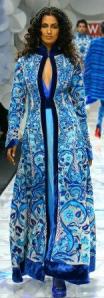Boundaries are fast melting and one often finds varied cultural flavours and inspirations doing the rounds on our runways. Kunal Majumder takes a close took at designers who have merged cultural identities and have drawn inspiration from Islamic patterns.

More than global, Indian fashion designers are making an effort to glocalise their fashion stance. The current Indian fashion scene is redefining boundaries by borrowing from national as well as international cultures. One such borrowing trend recently spotted on the runways finds its roots in Islamic culture. There are designers in both India and abroad who are infusing Islamic nuances in their creations. For instance, British designer Sophia Kara made an outfit composed of a hooded abaya with a matching niqab (face veil) in shocking pink over a salwar as part of her Imaan collection. That’s not all, high-end designer labels such as Hermès and Gucci are picking Muslim trends by doing a range of scarves and a number of other garments. But let’s just put aside international design trends and take a look at the Indian fashion industry. Islamic influences can be spotted in our part of the world in elegant kaftans, toga dresses and zuave pants. One is now able to see a lot of cultural exchange on the globe. Here’s one such positive influence.
Silhouettes
The underlying thought in Islamic fashion is that of modesty. Hence, while picking Islamic influences, designers have to make sure that they create clothes that don’t violate the Islamic dress code. Kaftans, ponchos, zuave pants and different version of culottes, all find their roots in Islamic fashion. The perfect example of this can be Kareena Kapoor’s kaftan look in the chartbuster Mauja hi mauja from the movie Jab We Met. Headscarves are an important component of Islamic ensemble and Renu Tandon is probably one of the few Indian designers to experiment with this accessory the most. Many Indian designers use Islamic silhouettes on Indian ramps – Malini Ramani, who has a major customer base in the Middle East, is one such designer. Other than her, designers like Rohit Bal, Zubair Kirmani and Monapali have drawn heavily from Islamic architecture and art forms.
Motifs and Designs
Middle Eastern and Turkish motifs and silhouettes are the new rage on the Indian runways. In the floral family flowered stems, jasmine, rose, and lotus motifs are the most
popular. Geometrical designs inspired from various Turkish and Mughal monuments can be found sitting on a number of dresses and famous Mughal jaalis have found an expression in many designers’ works.
Embroidery
Ritu Kumar, Meera Muzaffar Ali and Abu Jani Sandeep Khosla use traditional embroideries like chikankari and zardozi, which originated from Persia (Iran). A wedding trousseau by Tahiliani or saris by Kumar are unimaginable without zardozi, intricate
patterns in gold and silver studded with pearls and precious stones.
Zubair Kirmani, who hails from Kashmir, has successfully used the famous Kashmiri kashida work on his clothes. Kashida is a form of embroidery that draws inspiration from flowers, creepers, chinar leaves and mango motifs. Here’s a lowdown:
Rohit Bal
Rohit Bal is famous for his geometrical motifs that he picks from various Islamic structures. He claims that his latest collection – Siyaahi – was inspired from the ancient city of Constantinople. “The intrinsic inspiration is the art of the Iznik tiles of ancient Turkey. Their heritage of distinct deep blue and meticulous, intricate glazing evokes whispers of Mughal influence,” says Gudda…
For more pick up FnL, November issue
(c) Published in FnL, November issue